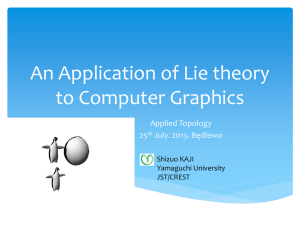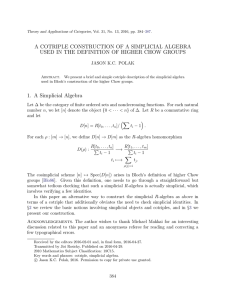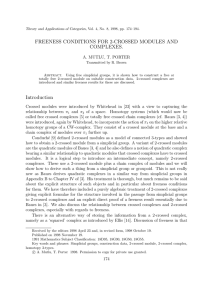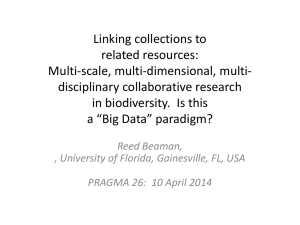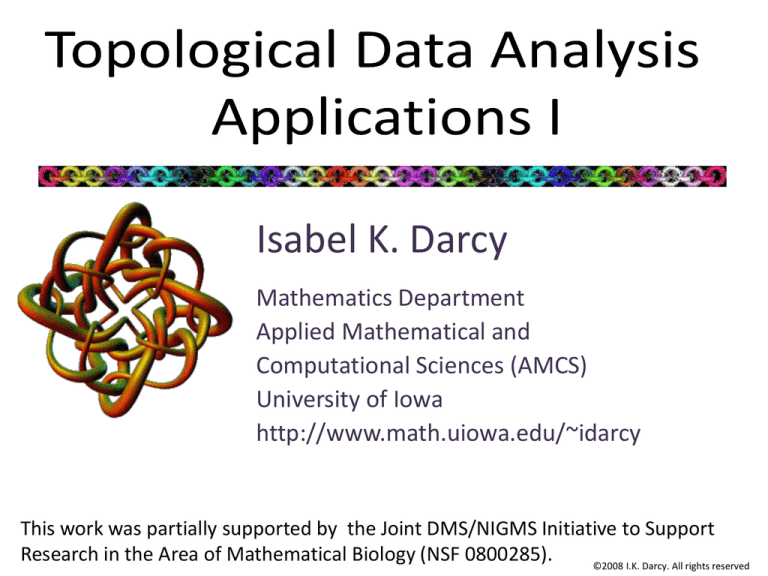
Isabel K. Darcy
Mathematics Department
Applied Mathematical and
Computational Sciences (AMCS)
University of Iowa
http://www.math.uiowa.edu/~idarcy
This work was partially supported by the Joint DMS/NIGMS Initiative to Support
Research in the Area of Mathematical Biology (NSF 0800285).
©2008 I.K. Darcy. All rights reserved
http://www.ploscompbiol.org/article/info%3Adoi%2F10.1371%2Fjournal.pcbi.1000205
2008
First paper to use only the spiking activity of place
cells to determine the topology (and geometry) of
the environment using homology (and graphs).
Edvard Moser
May-Britt Moser
John O’Keefe
http://www.nature.com/news/nobel-prize-for-decoding-brain-s-sense-of-place-1.16093
http://www.nature.com/news/neuroscience-brains-ofnorway-1.16079
May-Britt Moser
Edvard Moser
John O’Keefe
http://www.nature.com/news/nobel-prize-for-decoding-brain-s-sense-of-place-1.16093
http://www.ntnu.edu/kavli/research/grid-cell-data
http://www.ploscompbiol.org/article/info%3Adoi%2F10.1371%2Fjournal.pcbi.1000205
2008
First paper to use only the spiking activity of place
cells to determine the topology (and geometry) of
the environment using homology (and graphs).
place cells = neurons in the
hippocampus that are involved
in spatial navigation
http://en.wikipedia.org/wiki/File:Gray739-emphasizing-hippocampus.png
http://en.wikipedia.org/wiki/File:Hippocampus.gif
http://en.wikipedia.org/wiki/File:Hippocampal-pyramidal-cell.png
http://www.nytimes.com/2014/10/07/science
/nobel-prize-medicine.html
http://www.ploscompbiol.org/article/info%3Adoi%2F10.1371%2Fjournal.pcbi.1002581
2012 Ignoble Prize
The Ig Nobel Prizes honor achievements that make people LAUGH, and then THINK.
http://www.improbable.com/ig/
False Positives will occur
How can the brain understand the spatial
environment based only on action potentials (spikes)
of place cells?
http://upload.wikimedia.org/wikipedia/en/5/5e/Place_Cell_Spiking_Activity_Example.png
How can the brain understand the spatial
environment based only on action potentials (spikes)
of place cells?
http://upload.wikimedia.org/wikipedia/en/5/5e/Place_Cell_Spiking_Activity_Example.png
Idea: Can recover
the topology of the
space traversed by
the mouse by
looking only at the
spiking activity of
place cells.
http://www.ploscompbiol.org/article/info%3Adoi%2F10.1371%2Fjournal.pcbi.1000205
Building blocks for a simplicial complex
0-simplex = vertex = v
1-simplex = edge = {v1, v2}
v1
e
v2
Note that the boundary
of this edge is v2 + v1
2-simplex = triangle = {v1, v2, v3}
v2
Note that the boundary
of this triangle is the cycle
e1
e2
e1 + e2 + e3
v1
v3
e3
= {v1, v2} + {v2, v3} + {v1, v3}
Building blocks for a simplicial complex
3-simplex = {v1, v2, v3, v4} = tetrahedron
v2
v2
Fill in
v4
v1
v3
v4
v1
v3
boundary of {v1, v2, v3, v4} =
{v1, v2, v3} + {v1, v2, v4} + {v1, v3, v4} + {v2, v3, v4}
n-simplex = {v1, v2, …, vn+1}
Creating a simplicial complex
0.) Start by adding 0-dimensional vertices
(0-simplices)
Creating a simplicial complex
1.) Next add 1-dimensional edges (1-simplices).
Note: These edges must connect two vertices.
I.e., the boundary of an edge is two vertices
Creating a simplicial complex
2.) Add 2-dimensional triangles (2-simplices).
Boundary of a triangle = a cycle consisting of 3 edges.
Creating a simplicial complex
3.) Add 3-dimensional tetrahedrons (3-simplices).
Boundary of a 3-simplex
= a cycle consisting of its four 2-dimensional faces.
Creating a simplicial complex
n.) Add n-dimensional n-simplices, {v1, v2, …, vn+1}.
Boundary of a n-simplex
= a cycle consisting of (n-1)-simplices.
Place field = region
in space where the
firing rates are
significantly above
baseline
http://www.ploscompbiol.org/article/info%3Adoi%2F10.1371%2Fjournal.pcbi.1002581
Creating a simplicial complex
Creating a simplicial complex
1.) Adding 1-dimensional edges (1-simplices)
Add an edge between data points that are “close”
Creating the Čech simplicial complex
U
U
1.) B1 … Bk+1 ≠ 0⁄ , create k-simplex {v1, ... , vk+1}.
Creating the Čech simplicial complex
U
U
1.) B1 … Bk+1 ≠ 0⁄ , create k-simplex {v1, ... , vk+1}.
Consider X an arbitrary topological space.
Let V = {Vi | i = 1, …, n } where Vi
X,
The nerve of V = N(V) where
The k -simplices of N(V) =
nonempty intersections of
k +1 distinct elements of V .
For example,
Vertices = elements of V
Edges = pairs in V which intersect nontrivially.
Triangles = triples in V which intersect nontrivially.
http://www.math.upenn.edu/~ghrist/EAT/EATchapter2.pdf
Consider X an arbitrary topological space.
Čech complex
Let V = {Vi | i = 1, …, n } where
Vi X , =
Mathematical nerve,
not biological nerve
The nerve of V = N(V) where
The k -simplices of N(V) =
nonempty intersections of
k +1 distinct elements of V .
For example,
Vertices = elements of V
Edges = pairs in V which intersect nontrivially.
Triangles = triples in V which intersect nontrivially.
http://www.math.upenn.edu/~ghrist/EAT/EATchapter2.pdf
Creating the Čech simplicial complex
U
U
1.) B1 … Bk+1 ≠ 0⁄ , create k-simplex {v1, ... , vk+1}.
Mathematical
Nerve Lemma: If V is a finite collection of subsets of
X with all non-empty intersections of subcollections
of V contractible, then N(V) is homotopic to the
union of elements of V.
http://www.math.upenn.edu/~ghrist/EAT/EATchapter2.pdf
Idea: Can recover
the topology of the
space traversed by
the mouse by
looking only at the
spiking activity of
place cells.
Vertices = place cells
Add simplex if place
cells co-fare within a
specified time period
http://www.ploscompbiol.org/article/info%3Adoi%2F10.1371%2Fjournal.pcbi.1000205
Cell group =
collection of place
cells that co-fire
within a specified
time period (above a
specified threshold) .
Simplices correspond
to cell groups.
dimension of simplex
= number of place
cells in cell group - 1
http://www.ploscompbiol.org/article/info%3Adoi%2F10.1371%2Fjournal.pcbi.1000205
2012 Ignoble Prize
The Ig Nobel Prizes honor achievements that make people LAUGH, and then THINK.
http://www.improbable.com/ig/
Activated
fMRI of dead salmon
The salmon was
shown images of
people in social
situations, either
socially inclusive
situations or socially
exclusive situations.
The salmon was asked
to respond, saying
how the person in the
situation must be
feeling.
http://blogs.scientificamerican.com/sc
icurious-brain/2012/09/25/ignobelprize-in-neuroscience-the-deadsalmon-study/
compared
to other
voxels
Recovering
the topology
Trial is correct
if Hi correct for
i = 0, 1, 2, 3, 4.
http://www.ploscompbiol.org/article/info%3Adoi%2F10.1371%2Fjournal.pcbi.1000205
Remodeling: the
hippocampus can
undergo rapid context
dependent remapping.
http://arxiv.org/abs/q-bio/0702052
http://www.ploscompbiol.org/article/info%3Adoi%2F10.1371%2Fjournal.pcbi.1002581
2012
2012
Time
Cycles
Time
Cycles
Time
Cycles
Time
Cycles
Time
Cycles
Time
Cycles
Time
Cycles
Time
Cycles
Time
Cycles
Time
Cycles
Time
Cycles
Time
Cycles
Time
Cycles
2012
Data obtained via computer
simulations
http://www.ntnu.edu/kavli/research/grid-cell-data
Note the above examples use the Čech
complex to determine the topology of the
mouse environment.
But often in topological data analysis for
computational efficiency, one uses the Rips
complex instead of the Čech complex.
Unfortunately there is no nerve lemma for
the Rips complex.
Creating the Vietoris Rips simplicial complex
0.) Start by adding 0-dimensional data points
Note: we only need a definition of closeness
between data points. The data points do not need
to be actual points in Rn
Creating the Vietoris Rips simplicial complex
Step 0.) Start by adding data points
= 0-dimensional vertices (0-simplices)
Creating the Vietoris Rips simplicial complex
1.) Adding 1-dimensional edges (1-simplices)
Add an edge between data points that are “close”
Creating the Vietoris Rips simplicial complex
2.) Add all possible simplices of dimensional > 1.
Vietoris Rips complex = flag complex = clique complex
2.) Add all possible simplices of dimensional > 1.
Creating the Čech simplicial complex
U
U
1.) B1 … Bk+1 ≠ 0⁄ , create k-simplex {v1, ... , vk+1}.
Creating the Čech simplicial complex
U
U
1.) B1 … Bk+1 ≠ 0⁄ , create k-simplex {v1, ... , vk+1}.

